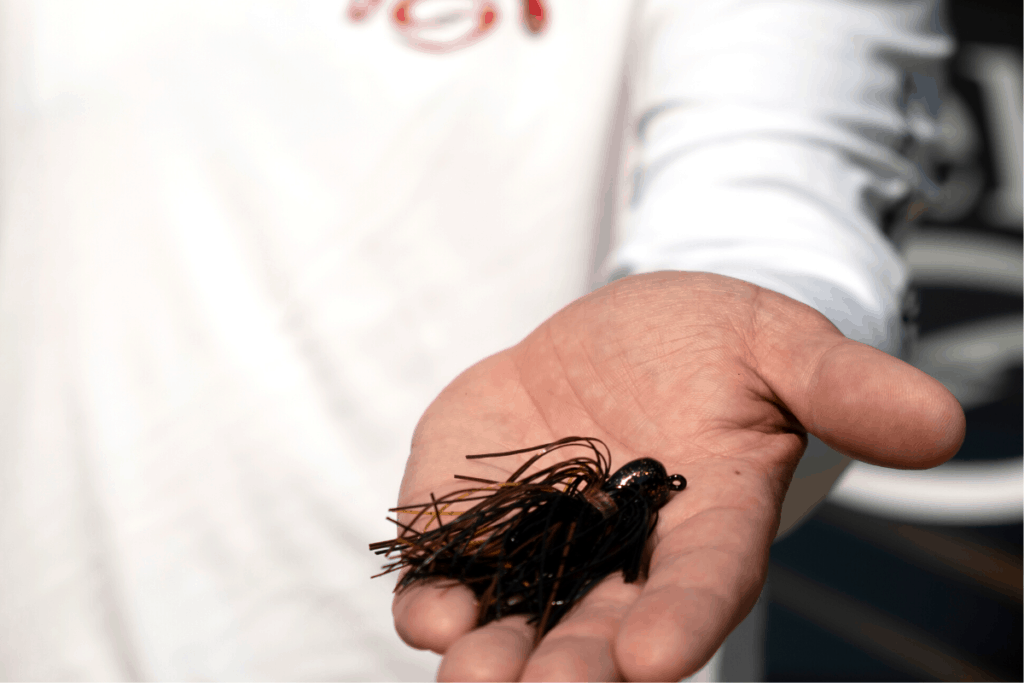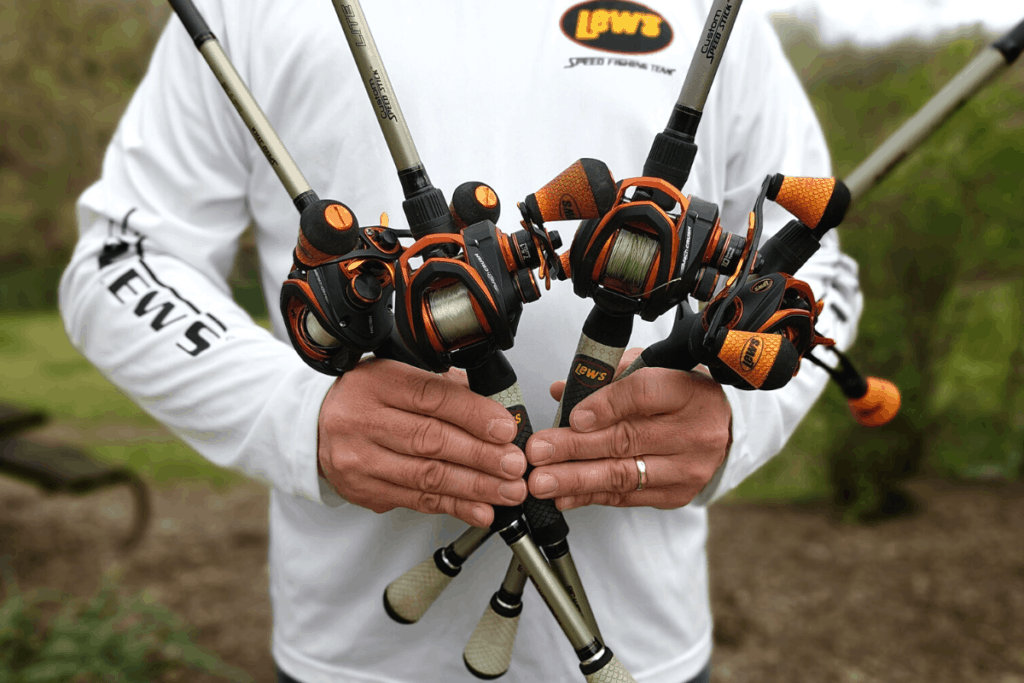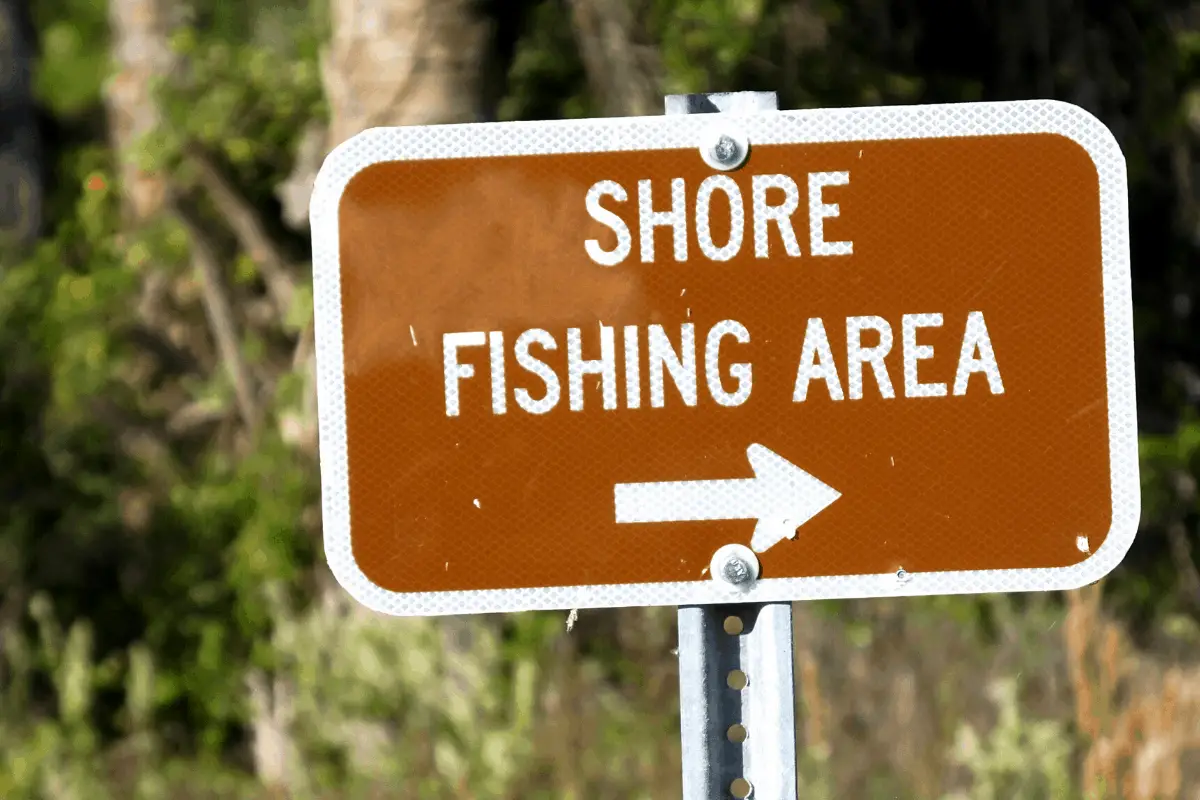A jig is a bass catching machine. It works. It works all year. Yet, shore anglers appear to be at a disadvantage when jig fishing. When the proper jig and weight is selected, it is possible to be an effective jig angler from the bank.
To be a successful jig bass angler from the shore select a jig that is lighter than you might choose when fishing from a boat. Pay attention to the bottom composition. If the lake or river bed is rocky, a football head will be a better choice. If fishing a location with sporadic vegetation a swim jig is a good option and if the weeds are emergent and thick, a heavy punching jig will be a shore anglers best choice.
Jigs are versatile lures that mimic a range of forage species that bass love. Using the shoreline to your advantage is key to catching bass with a jig when walking the bank.
The Size of Jig
Shore anglers are probing the water from the exact opposite direction that folks sitting in a boat do.
From the water, the bottom of the lake or river drops off and the angler fishes at a downhill slope. The natural slide away from the shoreline helps to eliminate the jig getting stuck and if a hangup occurs, a boat can be maneuvered to retrieve the lure.
Bank anglers have to deal with the bottom of the lake or river sloping upwards towards them. This causes a lot of issues with a jig getting wedged and hung up.
The result is lots of frustration and plenty of hard-earned money on the lake bed.

Go One Size Smaller
As a rough guideline, choose a jig that is one size smaller than what you may normally use if fishing from a boat.
Or, you can think about jig selection this way – go too light and slowly work your way back up.
How to Tell if You Have the Correct Size
The jig should pull along the bottom of the lake or river and make gentle contact.
In other words, it should not take a lot of effort from the angler to release the jig from the bottom and move it forward. An angler should be able to lift the rod tip in a gentle motion from the 9 o’clock position to about the 11 o’clock position with little resistance.
Size of Rocks
The larger the rock, the lighter the jig.
Big rocks have sizeable crevices between them that make it easy for jigs to slip into. If the jig is too heavy, they will wedge into these crevices and be almost impossible to get out because of the upwards slope of the shoreline.
Small rock or gravel means an angler can use a heavier jig with success.
It will take some trial-and-error, but paying close attention to the makeup of the lake or river bed will narrow down the proper size of the jigs you choose.
As You Move – Change Jig Size if Needed
The bottom composition of the water you are fishing can change abruptly. Pay close attention to this.
When fishing from the shore, it is handy to have two rods with. A different size jig can be tied onto each one and make covering various bottom compositions quick and efficient.
Jigs for Sparse Vegetation
If there is scattered, or sparse, vegetation along the shoreline being fished, it is hard to find a better lure than a swim jig.
The slender head design slides through weeds with ease.
A swim jig also does not need to make bottom contact since its primary objective is to mimic some sort of baitfish. This makes it an excellent choice for a variety of situations.
When selecting the proper swim jig, take notice of what types of baitfish are in the area. If the lake or river is full of shad choosing some sort of white or silver will be effective. If the water is teeming with bluegill be sure to choose the color that best matches the sunfish in that body of water.
Jigs for Heavy, Emergent Vegetation
If the shoreline is covered with thick mats of vegetation, a punching jig will be an optimum choice.
The bottom composition below thick weeds is rarely rocky.
This means the heavier jig should not get stuck as often when fishing in cover like this. Most punching jigs are at least ½ oz in size and often can be as large as 1 oz.
Shore anglers should still start lighter and then work their way up, even though there are probably few rocks in and around the heavy aquatic weeds.

Rod Selection for Jig Fishing From Shore
If there is room, it is always preferable to have a longer rod when bass fishing from the shoreline.
A rod 7ft or longer can extend the reach of the angler and help to efficiently fish areas that those in a boat cannot.
A good do-everything jig rod has a medium-heavy power rating with a fast action to it. When fishing thick and emergent vegetation, a rod that carries a heavy power rating will be a better choice.
Line Selection for Jig Fishing From Shore
If the water is dirty or has a substantial stain to it, go with a heavy braid. Something in the 50-65lb test range will work.
If the water has decent visibility, I prefer to use a fluorocarbon leader. Since getting stuck is always a concern for bank anglers, go with a slightly heavier fluoro leader than you might if fishing from a boat.
I would start with something in the 12lb test range and maybe work up to 15lb or 20lb test if the cover is thick enough.
Getting a few less bites but having enough strength to muscle a jig when stuck is a tradeoff most bank anglers are willing to make.
Presentation for Bank Fishing with a Jig
Stealth is the biggest advantage a shore angler has.
There is no banging around of a boat. The water does not move when displaced from the hull of the boat and sneaking up to a high-percentage brush pile from the shore is a highly-effective tactic.
Shore anglers can also drop, or dip, the jig into a likely bass-holding hangout with zero splash.
I have watched some amazing bank anglers over the years approach shoreline cover with extreme stealth and wrestle out some absolute monster bass. They catch fish that someone in a boat may never have been able to present a lure to.
Casting Parallel With the Bank
When it is possible, casting a jig parallel to the shoreline can be effective.
It reduces the possibility of getting stuck on the upward slope and can keep the lure at the optimum depth for a longer percentage of the retrieve.
Bank anglers who have mastered the roll cast can take full advantage of fishing the shoreline this way. It allows for precise casts amongst tight obstacles. A rod with a fast action makes roll casting much easier than one with too limber of a tip.
Bringing a Lure up the Slope
Many times when shore fishing, anglers cast the lure out towards the depths and retrieve it back up the slope.
When fishing like this I prefer to gently swim, or glide, the lure along the bottom. The goal is to maintain slight bottom contact but never let the lure settle down too much.
If the bass prefer the lure to be sitting for a period of time, which they often do, then I will use the lightest weight I have to minimize hang-ups.
The Bow-and-Arrow Lure Retrieval Method
It is inevitable that shore anglers get stuck and have no way to reach the lure. If the bait is wedged between rocks, this bow-and-arrow method does an excellent job of popping the lure free.
This method does not work well if the hook is embedded into something like a tree limb.
First, raise your rod tip up and remove any slack line. The line should be tight, but not too taught.
With your other hand, grab the line about half way up the rod. Pull the line toward you and snap it. As the line snaps, slightly lower the rod tip.
To help you visualize what this does to the lure, think about a garden hose laying on the ground. Remember when you were a kid and grabbed the hose at one end and whipped it up and then down quickly?
A bell curve would then run down the length of the hose.
This lure retrieval method is essentially doing the same thing, but with fishing line. It takes some practice, but this method can be a shore anglers best friend. Especially when fishing a rocky lake or river bed.
Final Thoughts
Shore anglers have many advantages, one of the most important is stealth. Approaching a great looking area without the bass knowing you are there is something that can yield some incredible catches.
One of the downsides of shore angling, is that jig fishing can be limited since it is a traditional bottom-bouncing bait.
Following these suggestions can make a jig one of a shore anglers most versatile tools.
Tight lines. Be safe and make sure to go out and encourage someone today. You never know how you may change their life forever.
Isaiah 6:8

